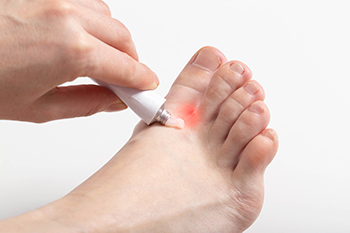Dermatophytes are the most common types of fungi that grow on the top layer of skin (epidermis) and enter it through small cracks. This condition, known as athlete’s foot, can cause scaly, itchy, and red skin. Severe cases of athlete’s foot can include very bad scaling and cracking in the skin, as well as blisters and a thickening of skin on the bottom of the feet. This may be particularly serious if you have diabetes. Athlete’s foot is highly contagious and can be transmitted by direct contact with someone who has it, as well as by sharing their clothes, shoes, linens, mats or rugs. Warm, moist areas such as public pools, showers, saunas and locker rooms are a perfect breeding ground for dermatophytes, so walking barefoot in these areas should be avoided. In order to properly diagnose athlete’s foot, a podiatrist may need to take a sample of the fungi from your skin for testing. If you believe you have athlete’s foot, it is suggested that you seek treatment from your podiatrist, who may recommend prescription antifungal medicines and topical creams to get rid of your athlete’s foot and avoid a bacterial infection from setting in.
Athlete’s foot is an inconvenient condition that can be easily reduced with the proper treatment. If you have any concerns about your feet and ankles, contact Dr. John P. Beaupied from Palos Podiatry. Our doctor will treat your foot and ankle needs.
Athlete’s Foot: The Sole Story
Athlete's foot, also known as tinea pedis, can be an extremely contagious foot infection. It is commonly contracted in public changing areas and bathrooms, dormitory style living quarters, around locker rooms and public swimming pools, or anywhere your feet often come into contact with other people.
Solutions to Combat Athlete’s Foot
- Hydrate your feet by using lotion
- Exfoliate
- Buff off nails
- Use of anti-fungal products
- Examine your feet and visit your doctor if any suspicious blisters or cuts develop
Athlete’s foot can cause many irritating symptoms such as dry and flaking skin, itching, and redness. Some more severe symptoms can include bleeding and cracked skin, intense itching and burning, and even pain when walking. In the worst cases, Athlete’s foot can cause blistering as well. Speak to your podiatrist for a better understanding of the different causes of Athlete’s foot, as well as help in determining which treatment options are best for you.
If you have any questions please feel free to contact our office located in Palos Heights, IL . We offer the newest diagnostic and treatment technologies for all your foot and ankle needs.




